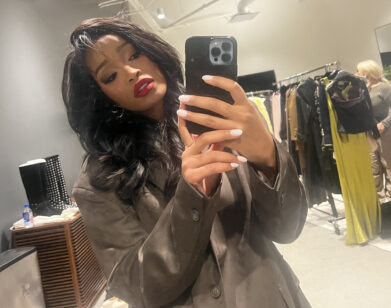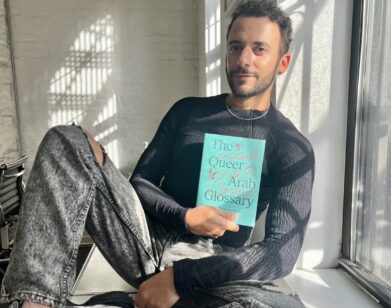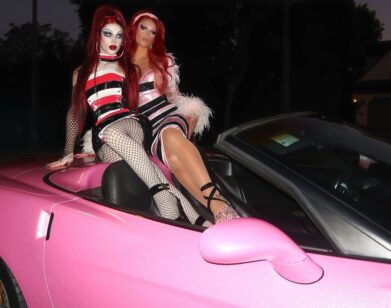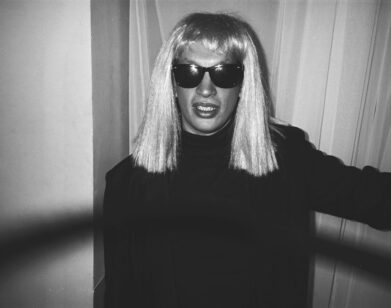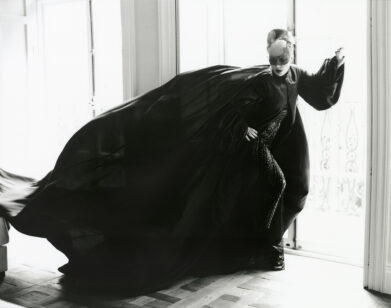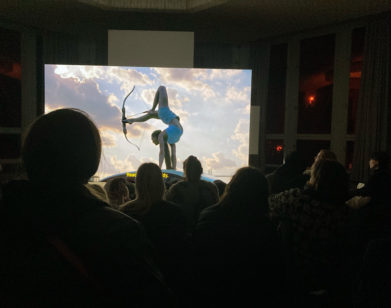SCULPT
“Is Being an Artist a Kink?”: Jack O’Brien, in Conversation With Tarek Lakhrissi
You probably recognize most of the items that comprise Jack O’Brien’s sculptures: discarded light bulbs, frayed seatbelts, cable ties, metal spoons. But then again, you might not. The London-based artist transforms everyday objects into larger-than-life structures, twisting, squeezing, and binding them together to create an uncanny distortion of reality. His new exhibit at Camden Art Center in London, The Reward, employs that same method of misuse. He displays a pair of spiral staircases encased in translucent stockinette and fitted with metal balls. Theoretically, the staircases could be used, but O’Brien has suspended them from the ceiling horizontally, thereby suspending their utility, too. “They’re pulled so far from their original state,” he told fellow artist Tarek Lakhrissi. “But the interesting thing for me is that they still hold on to what they actually are.” Lakhrissi, whose work is now on exhibition at Reiffers Art Center, also revels in disruption: the unfixed meanings that emerge when (seemingly) disparate objects and people interact. With both artists exhibiting their work this week at Art Basel Paris, at Capitan Petzel and Galerie Allen respectively, O’Brien called his longtime friend to talk about such “states of potential,” the RuPaul industrial complex, and why being an artist is a kink.
———
JACK O’BRIEN: So you were in New York?
TAREK LAKHRISSI: I was in New York, but I just came back yesterday.
O’BRIEN: Was it your first time?
LAKHRISSI: No, I’ve been there a couple times. But I think it’s the first time that I’ve been there and felt like I was not impressed. I mean, New York is so decadent in a way, but it’s also a very intense city.
O’BRIEN: Or just an intense country. I don’t know, I had such a fun time being in L.A., but it was a totally alien experience.
LAKHRISSI: How did you feel as a Brit in the US?
O’BRIEN: L.A. was interesting because I don’t drive, so I ended up going downtown quite a lot to find things. I’m just always on Facebook Marketplace.
LAKHRISSI: How was yesterday for you, the opening?
O’BRIEN: Yeah, it was a very intense day. In the first room before you go into the main one, I have these two cabinets with bollards that are set into them. So last minute, I was figuring out those configurations. But you’ve seen my work over the years. I love the moments where there’s that kind of energy invested in last-minute decisions. It worked really well because you have no time to overthink.
LAKHRISSI: I just saw pictures on Instagram, and it feels like every piece has their own rhythm in the space. Can you tell us more about the pieces, the sculptures?
O’BRIEN: Just before we were having this chat, I was looking at your show at the Migros Museum. And you were speaking about the acts that lead us through a sense of narrative or a journey within the show. But that’s something that I’ve thought about because this is the first time I’m doing an institutional show and have the space to think about the show as a whole—to have these poetic interventions. The crucial main part of it was the staircase sculpture, which is called The Reward. It has this stockinette that wraps it, and then silver Christmas balls that are melted onto it. I really wanted the stairs to have this particular rhythm and movement. The balls are very directly referencing that sense of punctuation. I kind of see them as notation within music.

Jack O’Brien – The Reward, Camden Art Centre. Courtesy the artist, Ginny on Frederick, Capitan Petzel, Matthew Brown. Photo: Rob Harris.
LAKHRISSI: And it looks quite spectacular. I’m interested in the stairs because my work is also related to access. Where does this question of the stairs come from? I love that.
O’BRIEN: Obviously, we chat and we’ve been friends for ages. But potentiality is something that I see in what we’re both doing. Like in Cruising Utopia, the states of potential and becoming and the horizon. I realized, “Oh, this is what frames how I think about sculpture, that kind of looseness.” I mean, the stairs are so directly a symbol of a state of becoming and an endpoint. And in the main room, the windows are abstracted and I’ve left this horizon line. You’re thinking around that frame of reference as well, right?
LAKHRISSI: Yeah. And also, there’s this funny connection with my title, which is Bliss, and your title, The Reward. I feel like it’s kind of—
O’BRIEN: Kinky.
LAKHRISSI: Absolutely. There’s this whole kinky thing about it. And the question of giving and receiving. Cruising Utopia is also a huge inspiration for me, and I love your discussion of potentiality. Bliss is very playful in a way, this enormous purple devil laughing at you. But it’s also kind of a comment on the gallery world and access, especially when you start to make works about kinks and queerness and dreams. There is this question of humor and how to have fun in these spaces.

Tarek Lakhrissi – Bliss, Migros Museum für Gegenwartskunst. Courtesy the artist and Galerie Allen, Paris. Photo: Studio Stucky © ProLitteris, Zürich
O’BRIEN: No, I see that. I always think about the material states and shininess in your work, which has this kind of expanded concept within your sculptures.
LAKHRISSI: I feel like we have both this interest with shininess. Shine is seduction in a way, because those pieces can really attract the eye. But then you see many layers. We understand quickly that there are different understandings of these objects. You kind of disrupt their primary action. In your work, I feel like the presence of plasticity and metallics is a very sexy way to put that into the world.
O’BRIEN: Yeah, I love playing with these hyper-glossy luscious objects. But also, I like the moments where those material states can be disrupted slightly and the ephemeral markings shift beyond that impenetrable state. It feels a bit more true to how we actually live or experience things. So you’ve got the big show coming up.
LAKHRISSI: Yeah, at Reiffers. It’s kind of like a continuation of the Migros Museum show where I was very intrigued with the question of acts and transformation, how when you navigate different places, you experience a different emotion in relation to space, sculptures, light, and videos. This new show, it’s very interesting because it’s this mentoring format with Ugo Rondinone. So I get to spend a lot of time with him and learn about what it means to be an artist, what it means to be relevant, and what it means to ask yourself the right questions. Being able to be in relation to this enormous artist who was so generous, so present, and so dedicated really allowed me to feel super safe to experiment. But also to go back to older pieces, I was interested in bringing into a Parisian context. I’ve brought back this enormous bed that I showed three years ago, inspired by Daria, the cartoon character. There is “Hard to Love,” my first video about language and poetry that I got to present with Vincent Honoré, rest in peace. Anyway, it’s a lot of old works that I’m showing again, so I’m very excited.
O’BRIEN: Well, it’s something that I’ve been figuring out as well, this network of pieces. There’s a continuation, especially through some of the materials that I’m using. These things start to inform each other at different moments. A piece from, I don’t know, three years ago starts to find its way back.
LAKHRISSI: For me, it’s also like a metaphor of our relationships. Old connections actually become very inspiring in the present and for the future. I love that we are still in relation, and I was so happy to see in London two or three weeks ago. We were sharing this moment of, “Look at us now.”
O’BRIEN: Totally. I was trying to think of when we first met, which was quite a while ago. But I remember talking about RuPaul’s Drag Race or something. Do you still watch it?
LAKHRISSI: Of course. I still watch, yeah.
O’BRIEN: I was just not into it.
LAKHRISSI: You’re not into it?
O’BRIEN: I think it just got too big. The RuPaul industrial complex got too much for me.
LAKHRISSI: It’s true. I think it’s more of a habit for me to watch it now. I’m not really interested in what’s happening. I just love how stupid it is.
O’BRIEN: To be honest, it feels like I’m being told to love it. And it just makes me not to not want it.
LAKHRISSI: Yeah, it’s like this weird situation where we have to enjoy RuPaul because we’re gay or queer or whatever. But fuck it. What are you watching right now?
O’BRIEN: The main thing that I keep watching is straight people in these really intense reality shows. There’s one called Married at First Sight, where all these 25-year-olds desperately say this is their last chance at love. Seeing the institution of marriage in this completely bizarre format is just unhinged and hilarious. I mean, I think a lot about the commodification of queerness. Obviously, RuPaul is such a light example. But when it comes to thinking about kink and fetish and these very fixed ideas of what people would perceive as “looking queer,” which inherently goes against the whole idea of it, my earlier works were dealing with specific clothing. It’s now become a bit more abstracted, but there is still a sensibility around unpacking these symbols within contemporary culture.
LAKHRISSI: Yeah, and working on the symbols is very fun and deep at the same time because our culture has a superficial interest in aesthetics, I would say. I feel like in both of our works, we try to disrupt them in a way or add different layers, but always in a playful way. I love that we are able to be in a space where it’s possible to be that experimental, given the whole seriousness around queerness and the art world and how people are supposed to play the game.

Tarek Lakhrissi – Bliss, Migros Museum für Gegenwartskunst. Courtesy the artist and Galerie Allen, Paris. Photo: Studio Stucky © ProLitteris, Zürich
O’BRIEN: Yeah, it’s something I’ve thought about a lot: the very formal, definite structures that exist. One is queerness, and one, as you said, is the institution of the art world. Something that I think we are both navigating is how these works act within a commercial gallery setting and what it means to disrupt and play within it. I’ve seen your work progress from something that had ephemerality to now, where things are a bit more fixed. I’m curious to hear how that’s been. Because when you were first making things, there was more of a focus around performance, right?
LAKHRISSI: Art performance, poetry readings, and also films. Because in a way, performance and films are the most accessible when you start. But at some point, I got frustrated focusing on just one or two mediums. I wanted to experiment more, and that’s why I started to add sculptural works and art installations. I wanted to add a whole mix of everything to make sure that I’m not fixed and won’t be tokenized in terms that I don’t want. I’m always interested in this question of escaping, always escaping and never. That’s why I love what you said about fixed things because I always want to make sure that it’s impossible to catch me where you want to catch me.
O’BRIEN: All the artists I love and adore have always done that. Your approach is challenged a bit, and you start to second-guess things, but it makes it more exciting. Especially with The Reward, I was thinking about that kind of escape. The idea was to make something that seems so monumental, to play within the realms of these kind of macho sculptors that make things at such a large scale. But at the end of the day, everything comes apart. They are quite cheap materials that are collapsible.
LAKHRISSI: They’re ambivalent.
O’BRIEN: Yeah, exactly. There’s a humanity to it, but it still has a finesse.
LAKHRISSI: I love how you found your own language in all of this because it feels like there is this real joy in your work. Your language is so clear and powerful. When you were talking about disruption, I was even thinking about magic. Maybe it’s going too far, but there is something almost out of this world in your work because you transform objects. They become barely recognizable, but still recognized, because they’re put in a setting where they become weird.
O’BRIEN: They’re pulled so far from their original state, but the interesting thing for me is that they still hold on to what they actually are. There’s still a sense of legibility where you’re like, “Okay, I can still read that this is a staircase or cutlery or shirts.” I think the anchoring is really important for me because it pins it back down to earth after it goes into this very surreal space. And I see that in your work as well; things are pulled and pushed.
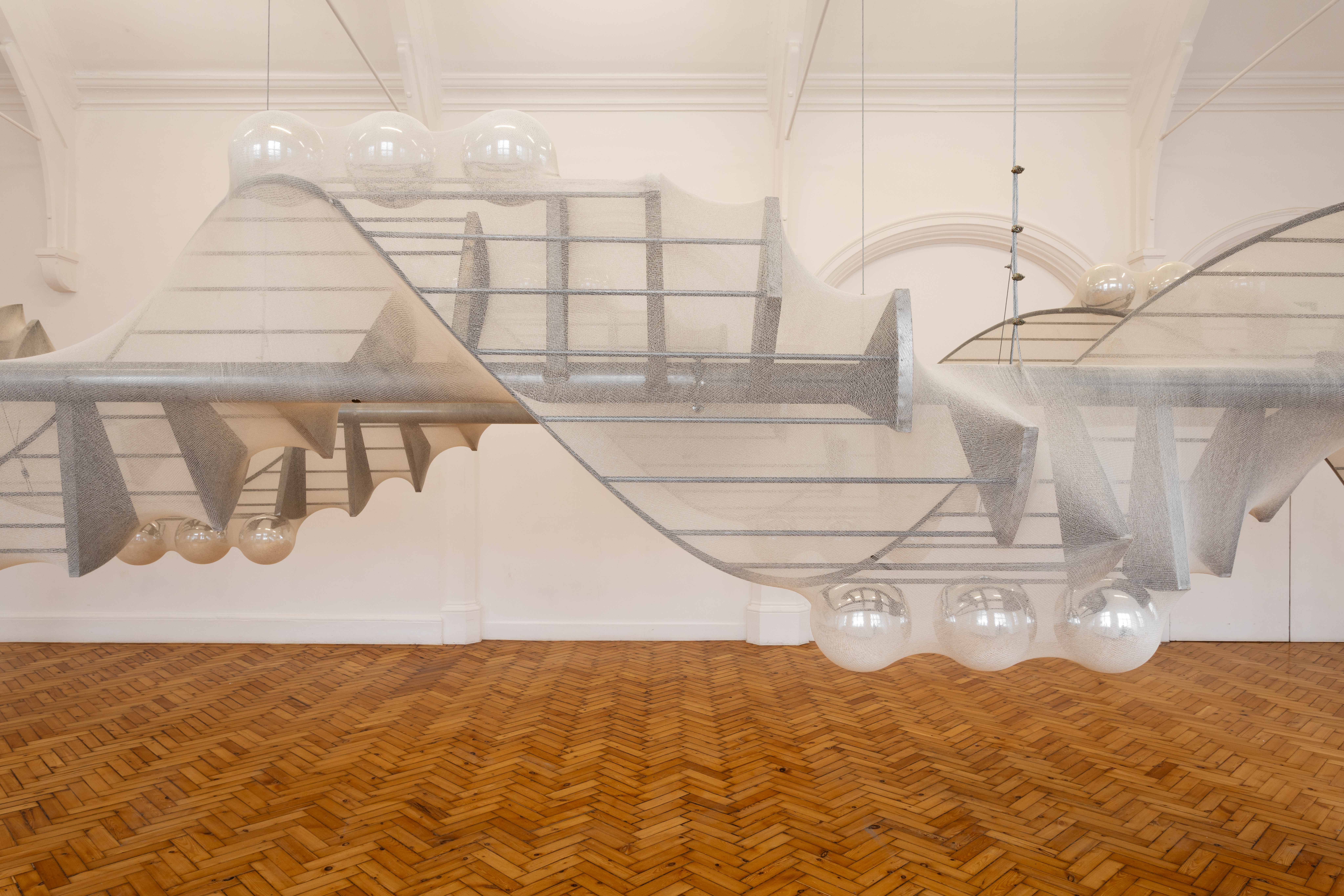
Jack O’Brien – The Reward, Camden Art Centre. Courtesy the artist, Ginny on Frederick, Capitan Petzel, Matthew Brown. Photo: Rob Harris.
LAKHRISSI: Yeah, I recently realized that my work is all about opening portals. There’s a rewritten queer version of Dante’s Inferno, where you follow this character in hell who arrives at lesbian bar. And this was, for me, a very important influence in my work: how one’s culture can bring you to another world. When you enter a gallery space, I want to make sure that you arrive in a place where time and space are suspended. You arrive in a different world.
O’BRIEN: Definitely. I’ve thought about it in The Reward. You are pushed further and further into this different realm of logic, but it still has these grounding moments. But I think horizons are maybe the crucial part of what I’ve been kind of exploring.

Jack O’Brien – The Reward, Camden Art Centre. Courtesy the artist, Ginny on Frederick, Capitan Petzel, Matthew Brown. Photo: Rob Harris.
LAKHRISSI: I have a weird question. Is being an artist is a kink?
O’BRIEN: Maybe. I’d say, yeah.
LAKHRISSI: I love thinking about cosplaying as an artist. When you cosplay in general, you’re performing another identity. It’s you, but in a different form.
O’BRIEN: Especially when you’re in it, that moment of finding the interconnectedness. It’s always when I’m performing the intuitive action of making art that feels kind of hot. Punching holes through things. Maybe it’s the act of doing it that I find quite kinky.
LAKHRISSI: No, it’s completely kinky. Recently, I was asking myself what it means to really know yourself deeply. I guess also being in New York, I was like, “Oh, it’s so interesting how the art world functions, what it means to be an artist, what it means also to exude desire in our practice.” Of course, it’s an old story– art and desire. I was very intrigued in New York by this circulation of desire, basically.
O’BRIEN: Do you think there’s an intensity in the city around posturing?
LAKHRISSI: Performing, absolutely. But there is also fighting and this kind of insolence of being yourself.


